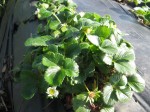All Wet
 Still reeling from the effects of last weekend’s drenching, and with three more major storms lined up across the Pacific due to arrive starting tonight, it certainly doesn’t feel like the first week of spring. If you follow weather patterns around here closely you know there is no “normal” when it comes to the rainy season. Even so, this has been a particularly strange year. If someone had told me that we would be at 120 percent of normal rainfall for this time of year, after receiving no rainfall for the entire month of January and part of February, I probably wouldn’t have believed them. It’s as if someone cut the seasonal calendar into pie shaped wedges and mistakenly reassembled it with a mid-summer piece in the depths of winter. And as enjoyable as that warm, dry break was, it appears that the rain we normally would have received then has simply been pushed back into spring.
Still reeling from the effects of last weekend’s drenching, and with three more major storms lined up across the Pacific due to arrive starting tonight, it certainly doesn’t feel like the first week of spring. If you follow weather patterns around here closely you know there is no “normal” when it comes to the rainy season. Even so, this has been a particularly strange year. If someone had told me that we would be at 120 percent of normal rainfall for this time of year, after receiving no rainfall for the entire month of January and part of February, I probably wouldn’t have believed them. It’s as if someone cut the seasonal calendar into pie shaped wedges and mistakenly reassembled it with a mid-summer piece in the depths of winter. And as enjoyable as that warm, dry break was, it appears that the rain we normally would have received then has simply been pushed back into spring.
When people ask me what effect these storms have on our farm, it’s difficult to give a simple answer. In the big picture, receiving this much rainfall is a good thing—lakes and reservoirs are topped off, local aquifers are recharged and rivers rise, allowing fish to spawn. And at the farm level, rain at the right time and in the right quantity can also be a good thing. It can save us the expense of having to irrigate, it can “sweeten” the soil by flushing out certain harmful salts, and if temperatures are warm, plants respond to rainwater better than any well-water.
The problems with rainfall usually relate to timing and quantity. At this time of the year, when our cover crops have matured and our greenhouse is full of transplants, we are waiting for the soil to dry out enough for us to get in with our tractors to prepare more ground for planting. In this regard, serious storms at this time of year can be a big set-back—especially on the poorly-drained, clay soils at our home farm. We were fortunate to have our new Lewis Road farm with its sandy soils to do our first plantings on, but here the problem has been the low temperatures associated with the cold-fronts, which means that things grow very slowly.
 And then there are the strawberries. This year we held over two acres of berries from last year. One of the good things about second year berries is that they come into production much earlier than first year plants. This can be great when the weather is good, but when it rains, the ripe fruit swells and cracks and becomes infected with botrytus (grey mold). One of our painful tasks for the past week has been sending a crew through the field to pick off all the ripe fruit and dispose of it away from the field to keep the botrytus from spreading to the plants and unripe berries. We would much have preferred sending that fruit to you in your CSA boxes if the weather had cooperated.
And then there are the strawberries. This year we held over two acres of berries from last year. One of the good things about second year berries is that they come into production much earlier than first year plants. This can be great when the weather is good, but when it rains, the ripe fruit swells and cracks and becomes infected with botrytus (grey mold). One of our painful tasks for the past week has been sending a crew through the field to pick off all the ripe fruit and dispose of it away from the field to keep the botrytus from spreading to the plants and unripe berries. We would much have preferred sending that fruit to you in your CSA boxes if the weather had cooperated.
The good news is that, according to the National Weather Service, the storm track will once again veer off to the north, and that next week should be dry here. The strawberry plants still have lots of flowers and immature green fruit, and given a couple of weeks of dry weather, you should start to see berries in your boxes soon.
Search High Ground Site
High Ground Favorites Cloud
apples arugula basil beets braise broccoli carrots cauliflower celery chard cheese cilantro dressing fennel fish herbs kale leeks lemon lettuce Meyer lemon mint mushrooms nuts onions oregano parsley peppers pork potatoes quickles radishes salad sauce saute scallions soup strawberries summer squash tomatoes topping vegan vegetarian vinaigrette winter squash


